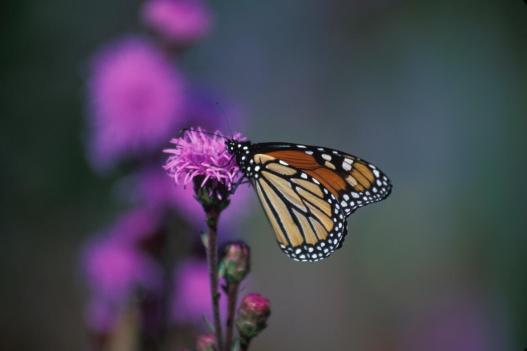March 2024 Edition | Volume 78, Issue 3
Published since 1946
Pollinators in our National Wildlife Refuges
The U.S. Geological Survey (USGS) New York Cooperative Fish and Wildlife Research Unit at Cornell University is leading pollinator research, in collaboration with Sam Droege’s USGS Bee Monitoring and Inventory Lab in Patuxent, Maryland and the U.S. Fish and Wildlife Service (USFWS) Region 5, to study the ecology of native bees in National Wildlife Refuges (NWRs) of the eastern United States.

Recent and rapid pollinator declines have generated conservation concerns resulting in petitions for listing of several species under the Endangered Species Act and listing of many pollinator species as species of greatest conservation need by state agencies. For example, almost 700 bees, moths, and butterfly species have been identified by states in the northeastern U.S. as species of greatest conservation need in their Wildlife Action Plans, with more than 60 rising to the level of Regional Species of Greatest Conservation Need.
To address declines in several taxa, the USFWS is proactively working with the New York Unit to understand their distribution throughout the Region 5, while seeking to understand how management actions impact their status. National Wildlife Refuges provide proving grounds for better understanding pollinator response to land-cover and land-use changes and to inventory our nation’s pollinators.
The overall research objectives are to:
- determine the distribution, status, life history, and ecology of regional pollinators throughout USFWS Northeast Region
- test effects of habitat availability, land use and land cover, and management actions on regional priority pollinator species and associated species
- link management activities to pollinator community trends
- attain more information on plant-pollinator networks priority pollinator species to guide vegetation restoration and management for conservation of at-risk, priority pollinator species and pollinators broadly.
In general, the USFWS needs information on priority, at-risk pollinator species and native pollinator species at large to inform effective management. In late 2021, the USFWS farmland pollinator planning team developed a workplan to guide science and conservation planning for the monarch butterfly and priority bumble bees in 2022. The group identified addressing data gaps pertaining to bumble bees and their life histories, distributions, ecology, responses to management practices, and status as a top science priority for 2022.
The study will attempt to elucidate ecological trends for bumble bee species, in addition to other native bees in NWRs. The status of cuckoo bumblebees – nest parasites of bumble bees – is inextricably linked to that of their host bumble bee species, necessitating the inclusion of those species in pollinator planning. In addition, the consensus among the scientific community is that more information is required for trends in native pollinators in general, especially to test whether NWRs serve as resource islands for pollinator populations and to better elucidate regional trends in pollinator response to land and water management in NWRs.
Refuge-specific information regarding management practices and pollinator communities is ripe for the testing; this effort is enacting a formal analysis of regional species responses to management in a range of forest and coastal Refuges. The researchers sampled pollinators at 10 NWRs in the eastern United States (USFWS Region 5) in 2022 and 2023, including Aroostook NWR (Maine), Moosehorn NWR (Maine), Sunkhaze Meadows NWR (Maine), 3 divisions within the Silvio O. Conte NWR Complex (Vermont), Pondicherry and Blueberry Swamp (New Hampshire), Wallkill River NWR (New Jersey), Blackwater NWR (Maryland), Chincoteague NWR (Virginia), and Back Bay NWR (Virginia).
The research team, including USFWS staff and volunteers, sampled pollinators in NWRS, using blue vane traps deployed in a monitoring program organized by Rachel Kelty, a Cornell master’s student. The researchers are identifying all captured bees to species, using taxonomic keys and reference collections at the Cornell University Insect Museum and the USGS Bee Monitoring and Inventory Lab, with assistance from U.S. Department of Agriculture collaborators at the Northern Plains Agricultural Research Laboratory (NPARL) in Sidney, MT, and experts in Cornell’s Department of Entomology.
Although pollinator surveys are regularly conducted throughout USFWS Northeast Region, these efforts can overlook certain areas and properties. For example, NWR properties are often not included in state bee atlases. USFWS staff (at the refuge and regional level) conduct species inventories on their properties, but limitations in funding and staff availability can make it difficult to maintain updated and complete inventories. Further, private forests also are largely excluded from state and regional surveys. Interactions between forest management and pollinator conservation are not well understood, leaving managers little information to guide management of pollinators in working forests and in matrices of forests and open habitat. The USGS study is filling these knowledge gaps by addressing effects of land management on pollinators in NWRs.
The Cooperative Research Unit Program enhances graduate education in fisheries and wildlife sciences and enables research between natural resource agencies and universities on topics of mutual concern. Rachel Kelty is a master’s student working in Dr. Steve Grodsky’s lab at Cornell University. This project provides a unique experience for Rachel to engage in pollinator conservation research, with an objective to provide information regarding pollinator conservation that informs USFWS management actions. Rachel has had over 5 years of experience participating in pollinator surveys and processing specimens. She was also a part of starting the Alaska Bee Atlas with the Alaska Center for Conservation Science, Anchorage, AK. She is looking forward to continuing research and finding out more about the pollinators in Region 5.
The ONB features articles from Cooperative Fish and Wildlife Research Units across the country. Working with key cooperators, including WMI, Units are leading exciting, new fish and wildlife research projects that we believe our readers will appreciate reading about. This article was written by Steve Grodsky, grodsky@cornell.edu, Assistant Unit Leader, New York CRU.